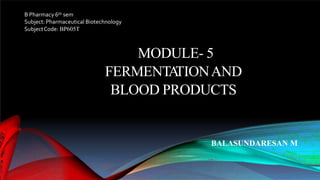This document provides an overview of fermentation and its history and applications. It discusses the objectives and learning outcomes of a course on pharmaceutical biotechnology. It defines fermentation and describes the key discoveries by Pasteur in establishing that fermentation is caused by living microorganisms. The document outlines the main types of fermentation based on the presence or absence of oxygen, and describes the mechanisms and examples of aerobic, anaerobic, ethanol, and lactic acid fermentation.




















![MECHANISM OF FERMENTATION
Fermentation takes place when the electron transport chain is
unusable (often due to lack of a final electron receptor, such
as oxygen), and becomes the cell’s primary means of ATP
(energy) production.[1] It turns NADH and pyruvate
produced in glycolysis into NAD+ and an organic molecule
(which varies depending on the type of fermentation; see
examples below). In the presence of O2, NADH and pyruvate
are used to generateA
TPin respiration. This iscalled](https://image.slidesharecdn.com/unitv-221022114734-b74705f0/85/FERMENTATION-pptx-21-320.jpg)

























![Platelet concentrates
Platelets separated from plasma obtained after 4-6
donations are pooled
or,
from a single donor by plateletapheresis
Composed of mainly platelets, some nonfunctional
WBCs, few RBCs & plasma[maintains pH].
volume= 50 ml contains 5.5x10^9/lt plts
Stored at 20-24oC
Shelf life- 5 days.. Once opened, transfuse within 6 hrs
1 unit of PC increases platelet count by: 5000-10000(adults)
20,000 (children)
75,000-1,00,000(infants)](https://image.slidesharecdn.com/unitv-221022114734-b74705f0/85/FERMENTATION-pptx-47-320.jpg)












